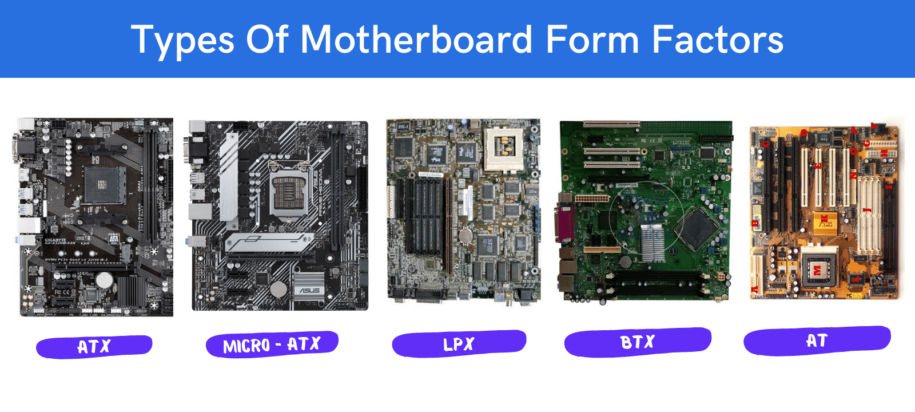The motherboard is the most important component of a computer. It is the “heart” of the system, which all other components connect to. The type of motherboard you choose will determine what kind of case you need, what kind of parts you can use, and how big your computer will be. There are several different types of motherboard form factors, the most common being ATX, Mini ITX, LPX, BTX, and AT.
1. ATX Form Factor
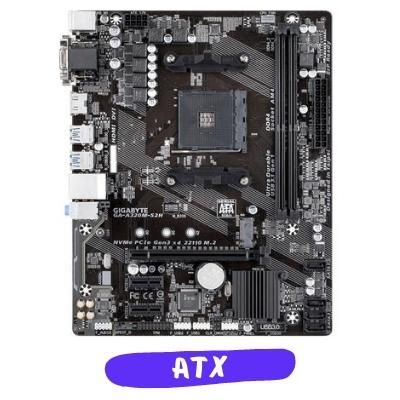
ATX is a motherboard form factor developed by Intel in 1995. It was the successor to the AT form factor and is the most popular form factor in use today. An ATX motherboard generally has more expansion slots and drive connectors than an equivalent microATX motherboard.
An ATX motherboard measures 305 mm x 244 mm (12 in x 9.6 in). The mounting holes for an ATX board are arranged in a grid of 7 by 7 cm (2.8 by 2.8 in). The standard specifies that boards may optionally have mounting points for additional boards stacked on top of them; these are not used on most modern motherboards.
The ATX specification includes provisions for several optional features, such as:
- An auxiliary power connector
- A keyboard connector
- Serial and parallel ports
- USB connectors
- A mouse connector
- Soundcard connectors
Not all of these features are present on every ATX motherboard. For example, many modern motherboards do not have a keyboard or mouse connector, as these devices are now connected via USB. Some boards also forego the use of a dedicated soundcard in favor of integrated audio circuitry.
ATX motherboards typically use a 24-pin connector for the main power supply and a 4-pin or 8-pin connector for additional 12V power. The 24-pin connector can be replaced with a 20-pin connector, but the 4-pin or 8-pin connector must be retained.
The ATX form factor is the most popular form factor in use today. It offers a good balance of expansion capabilities and easy installation and is used in a wide variety of computers, from entry-level systems to high-end gaming rigs.
2. Micro ATX Form Factor
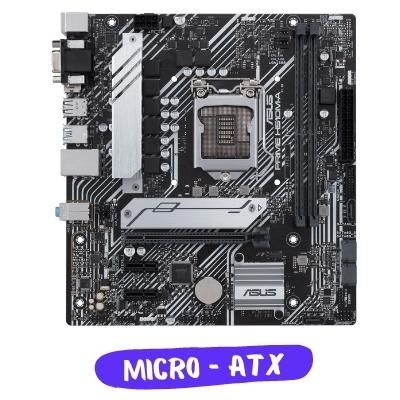
The Micro ATX motherboard form factor is the most popular form factor for consumer and small business PCs. It offers a good balance of features, performance, and expandability at a reasonable price. If you’re looking to build a new PC, the microATX form factor should be at the top of your list.
Here’s a look at the key features of the microATX form factor:
- Support for up to four DIMM slots for DDR4 memory, giving you up to 64GB of total memory capacity.
- A wide range of I/O options, including support for USB 3.0, SATA 6Gbps, and M.2 solid-state drives.
- Support for one or two PCIe x16 slots for graphics cards or other expansion cards.
- A variety of onboard audio and video options, including HDMI, DisplayPort, and DVI outputs.
If you need a little more power than what a microATX motherboard can provide, you can step up to a full-size ATX motherboard. However, unless you need the extra features and expandability that an ATX board offers, the microATX form factor should be more than enough for most users.
3. Mini ITX Form Factor
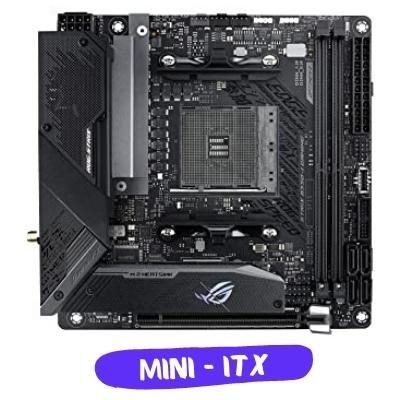
The Mini ITX motherboard form factor is a small form factor that is becoming increasingly popular in the PC industry. This standard was originally developed by VIA Technologies, and it is now also supported by Intel and other manufacturers.
Mini ITX motherboards are much smaller than ATX boards, measuring 6.7″ x 6.7″. They were first introduced in 2001 and were originally designed for small form factor PCs. Mini ITX boards usually have two expansion slots and a limited number of other connectors. However, they are still fully capable of running modern operating systems and software applications.
Mini ITX motherboards are typically much smaller than traditional ATX boards, and they often have fewer expansion slots and features. However, they can still be very powerful, and they offer a good balance of size, power, and performance.
If you are looking to build a small form factor PC, then a Mini ITX motherboard is a great option. These boards are designed to be very compact, and they offer a good balance of features and performance.
4. LPX Form Factor
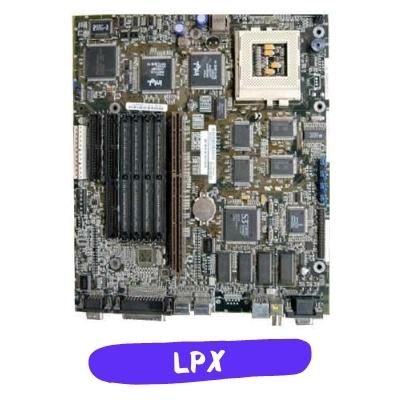
LPX motherboards are mostly found in older computers. They were introduced in 1987, and measure 13″ x 10″. LPX boards typically have five expansion slots and a variety of other connectors.
It has 9 or 10 mounting holes. The CPU socket is located in the center of the board with 4 RAM slots surrounding it. Most LPX boards have 2 ISA slots and 3 or 4 PCI slots. The power connector is located at the bottom right corner of the board.
LPX form factor was popular in the early 1990s for desktop computers. Many companies made LPX boards including ASUS, Gigabyte, MSI, and Foxconn. Today, the LPX form factor is not as common but it can still be found in some legacy systems.
5. BTX Form Factor

The BTX motherboard form factor was created in 2004 as a replacement for the aging ATX form factor. The main goals of the BTX form factor were to improve airflow and cooling within the computer case, as well as to allow for more efficient use of space.
BTX form factor is smaller than the ATX form factor and uses a different layout for the various components on the motherboard. One of the key features of the BTX form factor is the placement of the CPU and GPU (graphics processing unit) closer together, which allows for better communication between those two critical components.
In addition, BTX motherboards are available in a variety of sizes, but the most common size is the micro-BTX. Micro-BTX motherboards are approximately the same size as a deck of playing cards and can be used in both desktop and laptop computers. BTX motherboards are not compatible with ATX cases, so if you’re looking to upgrade your motherboard, you’ll also need to purchase a new case that supports the BTX form factor.
If you’re looking for better cooling and airflow in your computer, or if you’re simply looking to upgrade to the latest form factor, then a BTX motherboard may be the right choice for you. Be sure to check compatibility before making your purchase, as BTX and ATX are not compatible with each other.
6. AT Form Factor
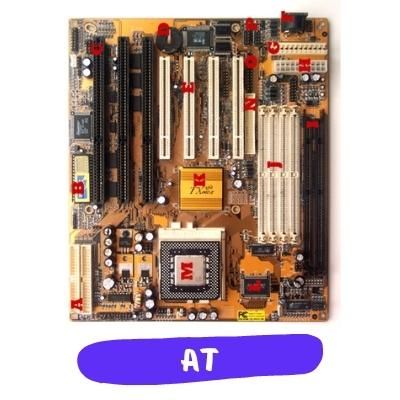
The AT motherboard form factor is a desktop computer motherboard form factor that was developed in 1984. It was the first motherboard form factor to use the now-standard ISA bus. The AT form factor is 12 inches x 13 inches.
The AT form factor was used in the IBM PC/AT, which was released in 1984. The PC/AT was the first personal computer to use an Intel 80286 processor. The PC/AT also introduced the 16-bit ISA bus, which became the standard bus for PCs until the introduction of PCI in 1993.
The AT form factor continued to be used in some PCs until the late 1990s when it was replaced by the ATX form factor. Many server and industrial computers still use the AT form factor.
They also have a variety of other connectors, including those for video, audio, and Ethernet. However, they are not compatible with modern operating systems and software applications.
What is Micro Pico-ITX motherboard?
Micro Pico-ITX motherboard is a small form factor motherboard designed to fit in very small cases or embedded applications. It is one of the smallest commercially available motherboards on the market. The Pico-ITX was introduced by VIA Technologies in 2007.
The Micro Pico-ITX form factor is just 10cm x 7.2cm (4″ x 2.8″). It is fully compatible with the Mini-ITX form factor and uses the same mounting holes. The smaller size makes it ideal for very small cases and embedded applications.
The Pico-ITX can be fitted with a wide range of processors, including the Intel Atom, VIA C7, VIA Nano, and AMD Geode LX. It also supports up to 2GB of DDR2 memory.
Furthermore, the Pico-ITX offers a wide range of I/O options, including VGA, DVI, HDMI, Ethernet, USB 2.0, and SATA. It also has an onboard audio codec and supports HD audio.
Finally, the Pico-ITX form factor is becoming increasingly popular for small form factor (SFF) PCs and embedded applications. Thanks to its small size and low power consumption, the Pico-ITX is an ideal solution for a wide range of applications.
Advantages:
- The Pico-ITX offers a very compact and small form factor.
- It is compatible with the Mini-ITX form factor and uses the same mounting holes.
- Pico-ITX can be fitted with a wide range of processors, including the Intel Atom, VIA C7, VIA Nano, and AMD Geode LX.
- It offers a wide range of I/O options, including VGA, DVI, HDMI, Ethernet, USB 2.0, and SATA.
- Pico-ITX has an onboard audio codec and supports HD audio.
Disadvantages:
- The small size of the Pico-ITX can make it difficult to work with.
- The Pico-ITX is not as widely available as other form factors.
- Pico-ITX motherboards can be more expensive than other form factors.
Comparision
Mini ITX vs. MicroATX vs. ATX
The Mini ITX form factor is the smallest of the three most common motherboard form factors. It measures just 6.7 × 6.7 inches (170 × 170 mm), making it about one-third the size of a MicroATX board and one-sixth the size of an ATX board.
Despite its small size, a Mini ITX board can pack a lot of features and power into a tiny package. Most Mini ITX boards include a CPU socket and support for up to 32 GB of DDR4 memory. They also have a variety of onboard connectors for SATA, USB, Ethernet, audio, and more.
The size and power constraints of the Mini ITX form factor make it ideal for building small, energy-efficient PCs. If you’re looking to build a mini PC or an HTPC (home theater PC), a Mini ITX motherboard is the way to go.
Mini ITX vs. Nano ITX
The Nano ITX form factor is even smaller than the Mini ITX form factor, measuring just 4.7 × 4.7 inches (120 × 120 mm). It was introduced in 2007 by VIA Technologies and has been adopted by a number of motherboard manufacturers, including ASUS, Gigabyte, and MSI.
Despite its small size, a Nano ITX board can pack a lot of features and power into a tiny package. Most Nano ITX boards include a CPU socket and support for up to 8 GB of DDR3 memory. They also have a variety of onboard connectors for SATA, USB, Ethernet, audio, and more.
The size and power constraints of the Nano ITX form factor make it ideal for building ultra-small, energy-efficient PCs. If you’re looking to build an extremely small PC or HTPC, a Nano ITX motherboard is the way to go.
Mini ITX vs. Pico ITX
The Pico ITX form factor is even smaller than the Nano ITX form factor, measuring just 3.9 × 2.8 inches (100 × 70 mm). It was introduced in 2008 by VIA Technologies and has been adopted by a number of motherboard manufacturers, including ASUS, Gigabyte, and MSI.
Despite its small size, a Pico ITX board can pack a lot of features and power into a tiny package. Most Pico ITX boards include a CPU socket and support for up to 4 GB of DDR3 memory. They also have a variety of onboard connectors for SATA, USB, Ethernet, audio, and more.
The size and power constraints of the Pico ITX form factor make it ideal for building ultra-small, energy-efficient PCs. If you’re looking to build an extremely small PC or HTPC, a Pico ITX motherboard is the way to go.
Mini ITX vs. Thin Mini-ITX
The Thin Mini-ITX form factor is a newer, smaller variant of the Mini ITX form factor that measures just 6.7 × 4.7 inches (170 × 120 mm). It was introduced in 2011 by Intel and has been adopted by a number of motherboard manufacturers, including ASUS, Gigabyte, and MSI.
Despite its small size, a Thin Mini-ITX board can pack a lot of features and power into a tiny package. Most Thin Mini-ITX boards include a CPU socket and support for up to 32 GB of DDR3 memory. They also have a variety of onboard connectors for SATA, USB, Ethernet, audio, and more.
The size and power constraints of the Thin Mini-ITX form factor make it ideal for building small, energy-efficient PCs. If you’re looking to build a mini PC or an HTPC, a Thin Mini-ITX motherboard is a way to go.
Mini ITX vs. MicroATX vs. ATX – Which One Should You Choose?
When it comes to choosing the right motherboard form factor for your PC build, it really depends on your needs and preferences.
If you’re looking to build a small, powerful PC, a Mini ITX motherboard is the way to go. If you’re looking to build an extremely small PC or HTPC, a Nano ITX or Pico ITX board is the way to go. And if you’re looking to build a mainstream PC, a MicroATX or ATX board is the way to go.
It really all comes down to your specific needs and preferences. So, which one is right for you? Only you can answer that question. But hopefully, this article has given you the information you need to make an informed decision.
Frequently Asked Questions
Difference Between ATX and BTX?
The primary difference between ATX and BTX is their cooling and airflow. BTX offers better cooling and airflow than ATX. The main reason for this is that BTX has a larger fan and more vents. Another difference is that BTX is shorter than ATX, which makes it easier to fit into smaller cases.
Finally, BTX motherboards use less power than ATX motherboards, which can result in lower electric bills. Despite these differences, both ATX and BTX are compatible with a wide variety of components and offer similar performance levels. As a result, the decision of which format to choose ultimately comes down to personal preference.
What are the 3 main form factors of motherboards?
You can think of a motherboard as the spine of a computer. All the other components connect to it, and it distributes power to where it’s needed. The three main form factors of motherboards are ATX, microATX, and mini-ITX.
ATX is the most common form factor, and it’s used in most desktop computers. MicroATX is smaller than ATX, and it’s often used in small form factor computers and all-in-ones. Mini-ITX is the smallest form factor, and it’s used in very small computers like the Intel NUC.
When choosing a motherboard, you need to make sure that it will fit in your case and that it has the right connectors for your other components. You also need to choose a chipset that’s compatible with your processor.
Which motherboard form factor is best?
As any PC builder knows, the motherboard is the heart of the system. It determines what components you can use, how fast your system will run, and how much expandability you’ll have. With so much riding on the motherboard, it’s important to choose the right form factor for your needs.
The most common form factors are ATX, microATX, and mini-ITX. ATX is the largest and most feature-rich option, offering support for multiple GPUs, plenty of expansion slots, and a variety of other features. MicroATX is a smaller version of ATX that sacrifices some expandability in exchange for a more compact footprint.
Mini-ITX is the smallest form factor available, offering only a limited number of expansion slots and features. Which form factor is best for you depends on your needs. If you want the most expandability and features, ATX is the way to go.
If you’re looking to build a small form factor system, mini-ITX is the best option. And if you’re somewhere in between, microATX is a good middle ground. Whichever form factor you choose, make sure it’s the right one for your needs.
What are the two main components of the motherboard?
The motherboard is the most important component of a computer. It is the main circuit board that everything else is connected to. The two main components on the motherboard are the CPU and the RAM.
The CPU is responsible for processing all of the information that the computer receives. The RAM is responsible for storing all of the information that the computer needs to access quickly. Without these two components, a computer would not be able to function.
What is Motherboard Form Factor?
The motherboard form factor defines the size, shape, and connector layout of a motherboard. The most common form factor for desktop computers is ATX, which was developed by Intel in 1995.
Today, there are a number of different form factors on the market, including Mini-ATX, microATX, and FlexATX. Each has its own advantages and disadvantages, so it’s important to choose the right one for your needs.
For example, miniaturized form factors like Mini-ATX are ideal for small-form-factor devices such as nettops and HTPCs. On the other hand, larger form factors like ATX offer more expanded capabilities, making them a better choice for high-end gaming PCs and workstations. Ultimately, the best motherboard form factor for you will depend on your specific needs and budget.
Conclusion
There are several other less common motherboard form factors, such as microATX, NLX, WTX, and DTX. However, the ones listed above are the most common.
When choosing a motherboard, you will need to consider what type of case you want, what kind of parts you need to use, and how big your computer will be.
Keep in mind that the type of motherboard you choose will determine what kind of case you need, what kind of parts you can use, and how big your computer will be.
